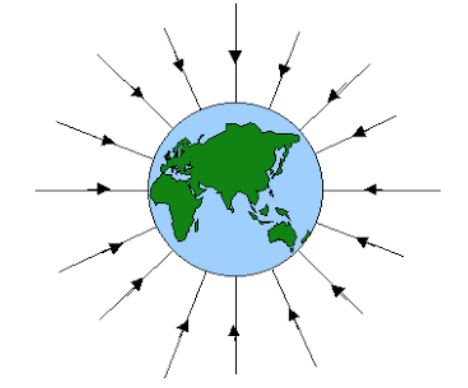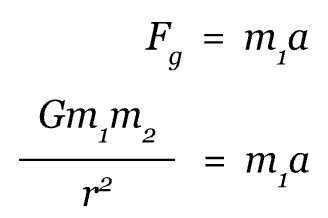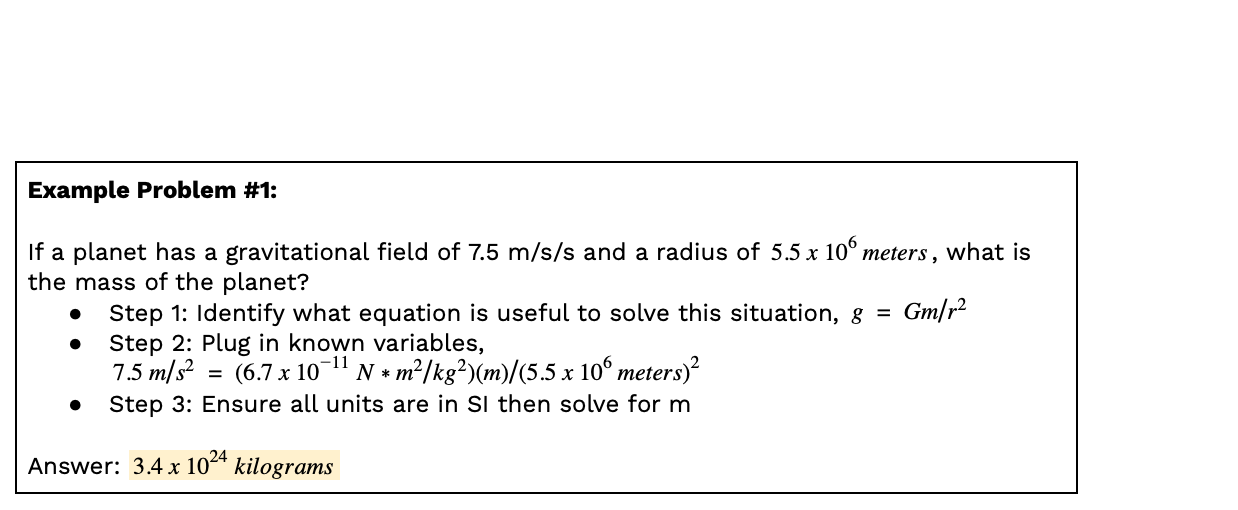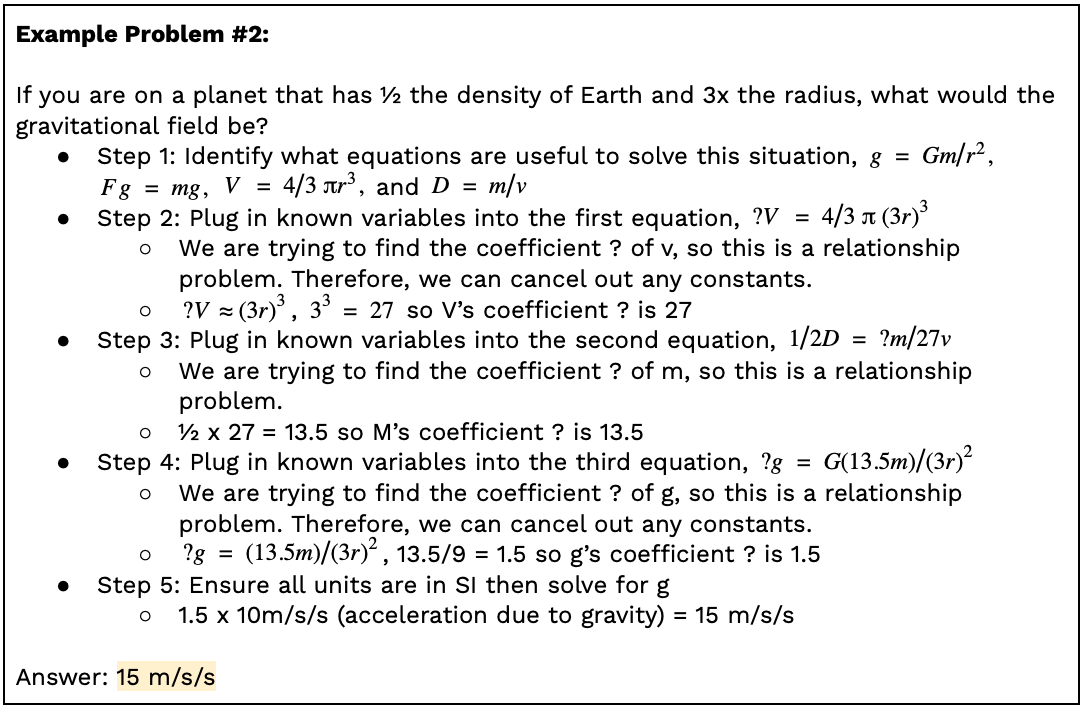
3.4 Gravitational Field/Acceleration Due to Gravity on Different Planets
5 min read•january 19, 2023
Peter Apps
Kashvi Panjolia
Peter Apps
Kashvi Panjolia
Overview
A g at the location of an object with m causes a of magnitude mg to be exerted on the object in the direction of the field.

Image courtesy of mechanicaltopdc.
As pictured in the image above, the weight or is always acting vertically downwards, towards the center of a planet. If this is the only force exerted on an object, the object is said to be in . If you recall from kinematics, an object’s acceleration is equal to the when in . The variable g, or the is subject to change based on the planet itself or the object’s location relative to the planet’s surface. On Earth, we know g as 9.8 m/s^2, but on other planets, the value is different.
Gravitational Field
A is a region of space in which a physical body, such as a planet or a star, exerts a force on any other body within that region. The force that a body experiences in a is caused by the presence of in the space around it. The strength of the at a particular point is represented by the per unit , also known as the gravitational acceleration (g). The can be represented by a vector field, meaning that it has both magnitude and direction.
The caused by a spherically symmetric object with is radial and, outside the object, varies as the inverse square of the radial distance from the center of that object. Sound familiar? The equation for a can be derived from the equation for and is used to find the of a planet or other object based on its . Let's derive it using for a satellite orbiting a planet:

Image courtesy of Lumen Learning.
Based on this free-body diagram of a satellite orbiting a planet, we know that F, the force of the planet's gravity, is the only force acting in the direction of the net force of the satellite. Since the satellite is in , the velocity of the satellite is not included in the net force calculation since it is tangent to the circle. We can now use and to relate the force between the satellite and the planet like this:

In this equation, m1 is the of the satellite and m2 is the of the planet. We use m1 on the right side of the expression because we are analyzing the forces acting on the satellite, not on the planet. From this equation, we can see that there is an m1 term on both sides of the equation so we can divide through by m1 to obtain:

Since the acceleration is caused only by the , we know that this is the equation for the acceleration of gravity, g.

This equation can be used to determine the acceleration of gravity for any planet given its and . To recap, in this equation, g is the in m/s/s, G is the 6.7 x 10^-11 N * m^2/kg^2, r is the in meters, and m is the in kilograms.
One more important idea we can glean from this equation is that the of the satellite or object in orbit doesn't matter, so the acceleration of gravity for all objects a certain distance away is the same, regardless of the of the object in orbit. Also, the r value in this equation represents the from the center of of the planet to the center of of the orbiting object, so you may have to add the distance an object is away from the planet to obtain the correct answer.


Practice Problems
1. How does the gravitational acceleration (g) on the surface of a planet change if the of the planet is doubled? a) It remains the same b) It is halved c) It is doubled d) It is quadrupled Answer: c) It is doubled
2. A planet has a of 6 x 10^24 kg and a of 6 x 10^6 m. Calculate the gravitational acceleration (g) on its surface.
a) 7.2 m/s^2
b) 9.8 m/s^2
c) 10.4 m/s^2
d) 18.6 m/s^2 Answer: d) 9.8 m/s^2
Explanation: g = Gm/r^2 = (6.67 x 10^-11 N*(m^2)/(kg^2))(6 x 10^24 kg) / (6 x 10^6 m)^2 = 9.8 m/s^2
3. How does the strength of the change if the distance between two masses is doubled? a) It remains the same b) It is halved c) It is quartered d) It is doubled Answer: c) It is quartered
4. An object is located at a distance of 2 x 10^8 m from a star with a of 2 x 10^30 kg. Calculate the (F) acting on the object.
a) -3.35 x 10^-6 N b) -4.92 x 10^-12 N c) -5.98 x 10^-9 N d) -6.67 x 10^-11 N Answer: d) -6.67 x 10^-11 N
Explanation: F = Gm1m2/r^2 = (6.67 x 10^-11 N*(m^2)/(kg^2))(2 x 10^30 kg)(1 kg) / (2 x 10^8 m)^2 = 6.67 x 10^-11 N
5. A planet has a of 6 x 10^24 kg and a of 6 x 10^6 m. What is the (F) acting on an object with a of 50 kg located on the surface of the planet? a) 3 x 10^9 N b) 3 x 10^10 N c) 3 x 10^11 N d) 3 x 10^12 N Answer: b) 3 x 10^10 N (F = Gm1m2/r^2, where m1= of the planet, m2= of the object, r= of the planet, and G= gravitational constant)
🎥Watch: AP Physics 1 - Unit 3 Streams
Key Terms to Review (10)
Acceleration due to gravity
: The acceleration due to gravity is the rate at which an object falls towards the Earth under the influence of gravity. It is approximately 9.8 meters per second squared (m/s^2) near the surface of the Earth.Circular Motion
: Circular motion refers to the movement of an object in a circular path around a central point. It involves constant change in direction but not necessarily speed.Free Fall
: Free fall occurs when an object falls under the sole influence of gravity, without any other forces acting upon it. During free fall, all objects experience acceleration due to gravity at approximately 9.8 m/s².Gravitational Field
: The gravitational field is the region of space around an object where another object experiences a force due to gravity. It represents the influence that a mass has on other masses in its vicinity.Gravitational Force
: Gravitational force is the attractive force between two objects with mass. It depends on the masses of the objects and the distance between them.Mass
: Mass refers to the amount of matter an object contains. It is a measure of the inertia or resistance to changes in motion.Newton's Second Law
: States that when a net external force acts on an object, the object will accelerate in the direction of the force. The acceleration is directly proportional to the net force and inversely proportional to the mass of the object.Newton's Universal Law of Gravitation
: Newton's Universal Law of Gravitation states that every particle in the universe attracts every other particle with a force that is directly proportional to the product of their masses and inversely proportional to the square of the distance between them.Radius
: The radius is defined as the distance from the center to any point on the circumference (outer edge) of a circle or sphere. It is half the diameter.Universal Gravitation Constant
: The universal gravitation constant, denoted as G, is a fundamental constant that appears in Newton's law of universal gravitation. It determines the strength of gravitational attraction between two objects with mass.3.4 Gravitational Field/Acceleration Due to Gravity on Different Planets
5 min read•january 19, 2023
Peter Apps
Kashvi Panjolia
Peter Apps
Kashvi Panjolia
Overview
A g at the location of an object with m causes a of magnitude mg to be exerted on the object in the direction of the field.

Image courtesy of mechanicaltopdc.
As pictured in the image above, the weight or is always acting vertically downwards, towards the center of a planet. If this is the only force exerted on an object, the object is said to be in . If you recall from kinematics, an object’s acceleration is equal to the when in . The variable g, or the is subject to change based on the planet itself or the object’s location relative to the planet’s surface. On Earth, we know g as 9.8 m/s^2, but on other planets, the value is different.
Gravitational Field
A is a region of space in which a physical body, such as a planet or a star, exerts a force on any other body within that region. The force that a body experiences in a is caused by the presence of in the space around it. The strength of the at a particular point is represented by the per unit , also known as the gravitational acceleration (g). The can be represented by a vector field, meaning that it has both magnitude and direction.
The caused by a spherically symmetric object with is radial and, outside the object, varies as the inverse square of the radial distance from the center of that object. Sound familiar? The equation for a can be derived from the equation for and is used to find the of a planet or other object based on its . Let's derive it using for a satellite orbiting a planet:

Image courtesy of Lumen Learning.
Based on this free-body diagram of a satellite orbiting a planet, we know that F, the force of the planet's gravity, is the only force acting in the direction of the net force of the satellite. Since the satellite is in , the velocity of the satellite is not included in the net force calculation since it is tangent to the circle. We can now use and to relate the force between the satellite and the planet like this:

In this equation, m1 is the of the satellite and m2 is the of the planet. We use m1 on the right side of the expression because we are analyzing the forces acting on the satellite, not on the planet. From this equation, we can see that there is an m1 term on both sides of the equation so we can divide through by m1 to obtain:

Since the acceleration is caused only by the , we know that this is the equation for the acceleration of gravity, g.

This equation can be used to determine the acceleration of gravity for any planet given its and . To recap, in this equation, g is the in m/s/s, G is the 6.7 x 10^-11 N * m^2/kg^2, r is the in meters, and m is the in kilograms.
One more important idea we can glean from this equation is that the of the satellite or object in orbit doesn't matter, so the acceleration of gravity for all objects a certain distance away is the same, regardless of the of the object in orbit. Also, the r value in this equation represents the from the center of of the planet to the center of of the orbiting object, so you may have to add the distance an object is away from the planet to obtain the correct answer.


Practice Problems
1. How does the gravitational acceleration (g) on the surface of a planet change if the of the planet is doubled? a) It remains the same b) It is halved c) It is doubled d) It is quadrupled Answer: c) It is doubled
2. A planet has a of 6 x 10^24 kg and a of 6 x 10^6 m. Calculate the gravitational acceleration (g) on its surface.
a) 7.2 m/s^2
b) 9.8 m/s^2
c) 10.4 m/s^2
d) 18.6 m/s^2 Answer: d) 9.8 m/s^2
Explanation: g = Gm/r^2 = (6.67 x 10^-11 N*(m^2)/(kg^2))(6 x 10^24 kg) / (6 x 10^6 m)^2 = 9.8 m/s^2
3. How does the strength of the change if the distance between two masses is doubled? a) It remains the same b) It is halved c) It is quartered d) It is doubled Answer: c) It is quartered
4. An object is located at a distance of 2 x 10^8 m from a star with a of 2 x 10^30 kg. Calculate the (F) acting on the object.
a) -3.35 x 10^-6 N b) -4.92 x 10^-12 N c) -5.98 x 10^-9 N d) -6.67 x 10^-11 N Answer: d) -6.67 x 10^-11 N
Explanation: F = Gm1m2/r^2 = (6.67 x 10^-11 N*(m^2)/(kg^2))(2 x 10^30 kg)(1 kg) / (2 x 10^8 m)^2 = 6.67 x 10^-11 N
5. A planet has a of 6 x 10^24 kg and a of 6 x 10^6 m. What is the (F) acting on an object with a of 50 kg located on the surface of the planet? a) 3 x 10^9 N b) 3 x 10^10 N c) 3 x 10^11 N d) 3 x 10^12 N Answer: b) 3 x 10^10 N (F = Gm1m2/r^2, where m1= of the planet, m2= of the object, r= of the planet, and G= gravitational constant)
🎥Watch: AP Physics 1 - Unit 3 Streams
Key Terms to Review (10)
Acceleration due to gravity
: The acceleration due to gravity is the rate at which an object falls towards the Earth under the influence of gravity. It is approximately 9.8 meters per second squared (m/s^2) near the surface of the Earth.Circular Motion
: Circular motion refers to the movement of an object in a circular path around a central point. It involves constant change in direction but not necessarily speed.Free Fall
: Free fall occurs when an object falls under the sole influence of gravity, without any other forces acting upon it. During free fall, all objects experience acceleration due to gravity at approximately 9.8 m/s².Gravitational Field
: The gravitational field is the region of space around an object where another object experiences a force due to gravity. It represents the influence that a mass has on other masses in its vicinity.Gravitational Force
: Gravitational force is the attractive force between two objects with mass. It depends on the masses of the objects and the distance between them.Mass
: Mass refers to the amount of matter an object contains. It is a measure of the inertia or resistance to changes in motion.Newton's Second Law
: States that when a net external force acts on an object, the object will accelerate in the direction of the force. The acceleration is directly proportional to the net force and inversely proportional to the mass of the object.Newton's Universal Law of Gravitation
: Newton's Universal Law of Gravitation states that every particle in the universe attracts every other particle with a force that is directly proportional to the product of their masses and inversely proportional to the square of the distance between them.Radius
: The radius is defined as the distance from the center to any point on the circumference (outer edge) of a circle or sphere. It is half the diameter.Universal Gravitation Constant
: The universal gravitation constant, denoted as G, is a fundamental constant that appears in Newton's law of universal gravitation. It determines the strength of gravitational attraction between two objects with mass.
Resources
© 2024 Fiveable Inc. All rights reserved.
AP® and SAT® are trademarks registered by the College Board, which is not affiliated with, and does not endorse this website.